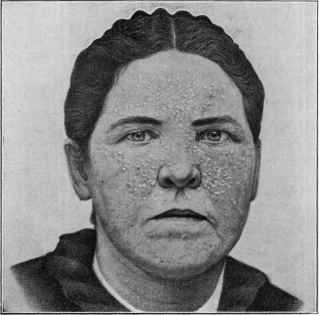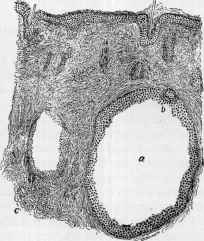| MEDICAL INTRO |
| BOOKS ON OLD MEDICAL TREATMENTS AND REMEDIES |
THE PRACTICAL |
ALCOHOL AND THE HUMAN BODY In fact alcohol was known to be a poison, and considered quite dangerous. Something modern medicine now agrees with. This was known circa 1907. A very impressive scientific book on the subject. |
DISEASES OF THE SKIN is a massive book on skin diseases from 1914. Don't be feint hearted though, it's loaded with photos that I found disturbing. |
1084 DISEASES OF THE APPENDAGES
HYDROCYSTOMA1
Synonyms.—Hidrocystoma; Cysts of the coil-ducts.
Definition.—A name applied to a noninflammatory affection
characterized by discrete pin-head to pea-sized, shining, translucent,
somewhat deep-seated, persistent vesicles appearing on the face.
Symptoms.—When a case comes under observation there are
ordinarily a number of lesions to be seen, of various sizes, discrete,

Fig. 267.—Hydrocystoma, showing the yellowish-white or pearly, deep-seated cysts or
vesicles (courtesy of Dr. G. T. Jackson).
occasionally here and there a few crowded closely together. They
are rounded or ovoid, translucent, solid-looking, tense, shining, whitish
literature: Under the name dysidrosis of the face: Jackson, Jour. Cutan. Dis.,
1886, p. 1 (with colored plate); Rosenthal, Deutsche med. Wochenschr., 1887, No. 20—
abs. in Monatshefte, 1887, p. 615; Jamieson, Brit. Jour. Derm., 1893, p. 134; Hallo-
peau, “Sur un case de dysidrose du nez,” Annales, 1892, p. 728. Under the name of
hidrocystoma: Robinson, Jour. Cutan. Dis., 1893, p. 293 (with colored plate and histo-
logic examination and cuts), and in Trans. Amer. Derm. Assoc. for 1884, and in Manual
of Dermatology, New York, 1884, under “Sudamen of the Face”; Jarisch, Verhandl.
der Deutsch. dermatolog. Gesell., V Congress, 1895; Adam, Brit. Jour. Derm., 1895,
p. 169 (refers to 9 cases; histologic examination, with 7 histologic cuts); Hutchinson,
ibid., p. 137 (with colored plate); Morton, ibid., p. 245 (daughter of one of Adam’s
cases); Thibiérge, Annales, 1895, p. 978 (4 cases, histologic examination, general review
of the subject, and a bibliography); Bassaget, “De L’hidrocystoma,” These de Paris,
July 24, 1896 (gives one new case with histologic study, and reviews previously published
cases); Crocker, Diseases of Skin, second ed., p. 731, briefly mentions 3 cases, but the
blotchy redness, pustular lesions, and, in 1 case, a trophic streaks and pits noted do not
accord with the conditions usually observed; Schidachi, “Experimentelle Erzeugung von
Hidrocystoma.” Archiv, 1907, vol. lxxxiii, p. 3 (with histologic cut).
HYDROCYSTOMA
IO85
or light-yellowish, projecting vesicles, with, in some of the largest, a
bluish tinge peripherally; they have a somewhat thick covering, and show
no tendency to spontaneous rupture. The deepest seated, usually the
beginning, lesions, as well as those tending to disappear, in which the
contents have been partly absorbed, look not unlike boiled sago-grains.
Upon the whole, the same appearances are maintained throughout.
There are no inflammatory symptoms. Most of the lesions are of the
size of a small pea, but many are smaller and some larger. Exceptionally
around the border of the large vesicles there may be a scarcely noticeable
hyperemic areola. The face is the seat of the disease. While in occa
sional cases the manifestation consists of but several lesions, which are
scattered or confined to limited area, as the nose only in Hallopeau’s
case, in most instances there
are 30 to 100 or more scattered
over this entire region. Ex
ceptionally the lesions are
found on one side of the face
only, as in Jamieson’s patient,
and associated with unilateral
sweating. They are persist
ent, and often last for weeks
or months, the contents re
maining clear and never be
coming purulent, and dis
appearing by absorption or
desiccation, leaving no trace
or a slight transitory pigmenta
tion. There is a complete or
partial disappearance during
the cold season, and, as a rule,
especially if subjected to the
causative factors, a reappear
ance as soon as the warm
weather sets in. Increased
sweating of the face is often
noticed. The eruption gives
rise to no trouble except the disfigurement; occasionally a tense feeling
or slight smarting is felt. Jackson noted in his case that the skin upon
light rubbing became easily hyperemic.
Etiology and Pathology.—With rare exceptions the disease
has been observed in middle-aged or older women, and especially in
those whose faces are subjected to a warm, moist atmosphere, as washer
women, and more particularly in those who perspire freely. Of the 30
to 40 patients observed by Robinson, all were women except 1; in Adam’s
9 cases were 3 men, and in Thibiérge’s 4, 1 man. Exacerbation has
been noted at the menstrual period, and following emotional or nervous
excitement (Hallopeau). The causative factor in the reported cases would
seem to be heat and steam moisture, as over the washtub and fire. My
own observations of 9 or 10 patients are in accord with these previously

Fig. 268.—Hydrocystoma, showing small
and large cysts (a) in the lower part of the
corium, an excretory sweat-duct at b, and a
sweat-coil at c. As the vesicle or cyst enlarges
it may extend to near the epidermis (courtesy
of Dr. A. R. Robinson).
1086
DISEASES OF THE APPENDAGES
observed facts. Inasmuch as out of the thousands of women so exposed
but few show the affection, there remains an essential factor other than
the above as yet unrecognized. The unilateral sweating noted in a few
instances, and the long-continued hemicrania in Hutchinson’s case,
indicated possible neurotic element. Thibierge has observed joint
pains and a disposition to obesity in such patients, as well as a marked
neurotic tendency. Adams, on the other hand, contrary to general
experience, stated that his 9 patients, except 1, were of the thin, active,
wiry type.
The lesion is a cyst-like formation of the duct of the sweat-gland,
and has its seat within some part of the corium; beginning in the deeper
part, and, as it increases in size, encroaching upon the epidermis. The
epidermis is normal; nor does the process involve the sebaceous glands
or hair-follicles. The cyst-wall is lined with two or more layers of
epithelial cells, taking their origin from the normal epithelium of
the duct; the contents consist of retained sweat, and are always acid
(Robinson).
Diagnosis.—The persistent, pearly-looking, translucent, non
inflammatory projecting vesicles, with their limitation to the face,
their occurrence usually in middle-aged women, and the history of
some duration, give a picture that can scarcely be mistaken for any
other affection. It should not be confounded with sudamen, pom-
pholyx, vesicular eczema, or adenoma of the sweat-glands. Sudamen
bears some resemblance, but the superficial nature and minute size
of the lesions, the distribution, generally most abundant on the trunk,
and, as a rule, scanty or entirely absent on the face, together with the
associated febrile or cachectic state and the short duration, are entirely
different from the symptoms of hydrocystoma.
Pompholyx, or dysidrosis, is a disease of the hands, or hands and
feet, and is acute in character, inflammatory, and runs a short course.
Vesicular eczema can scarcely be confounded with it, with its numerous
aggregated or confluent minute vesicles, usually rupturing spontaneously,
and the gummy oozing, with the presence of inflammatory symptoms,
an entirely different history, and the intense itching—symptoms strik
ingly different. Adenoma of the sweat-glands bears some similarity
on casual inspection, but the history of this formation and the character
of the contents are not like those of hydrocystoma. Milium could
scarcely be confused with it.
Prognosis and Treatment.—The disease is a mild disorder,
and beyond the disfigurement need not be the source of any anxiety.
It is, however, as a rule, persistent, with partial or complete abeyance
during the winter. With treatment and the avoidance of the exciting
causes—moist heat and work or exercise which provokes undue per
spiratory action—the condition can be removed. The measures re
quired are purely external and of a simple character, consisting in punc
turing of the lesions, through which the contained liquid can escape or
be pressed out, and the application of a bland dusting-powder. Rosen-
thal saw favorable influence from the use of a 1 to 2 per cent, alcoholic
solution of naphthol.
But first, if you want to come back to this web site again, just add it to your bookmarks or favorites now! Then you'll find it easy!
Also, please consider sharing our helpful website with your online friends.
BELOW ARE OUR OTHER HEALTH WEB SITES: |
Copyright © 2000-present Donald Urquhart. All Rights Reserved. All universal rights reserved. Designated trademarks and brands are the property of their respective owners. Use of this Web site constitutes acceptance of our legal disclaimer. | Contact Us | Privacy Policy | About Us |